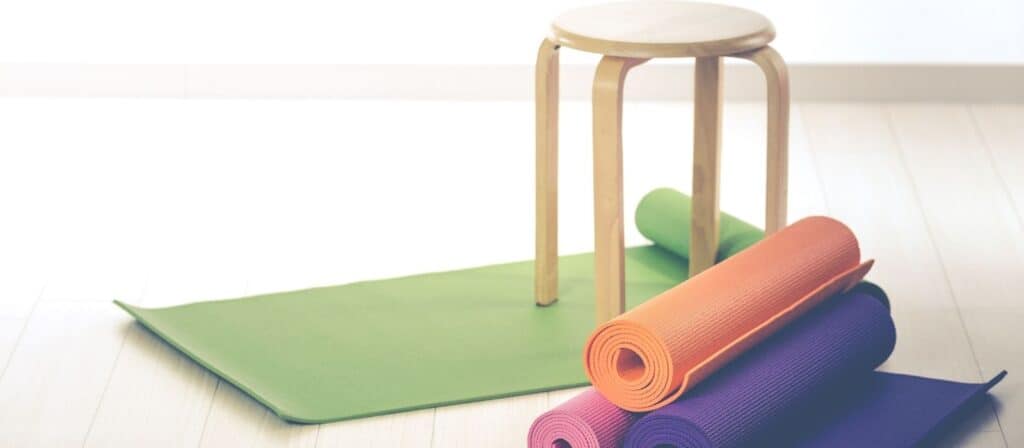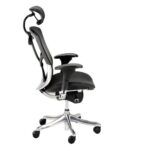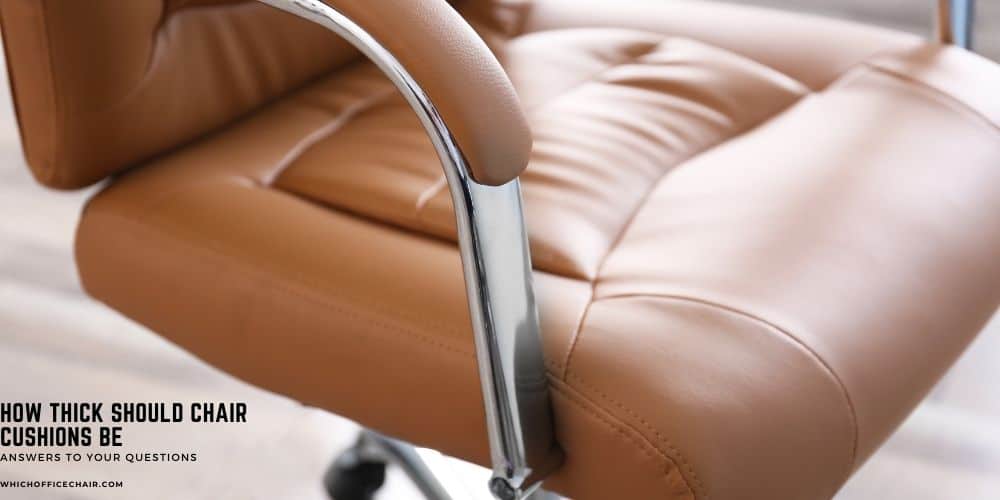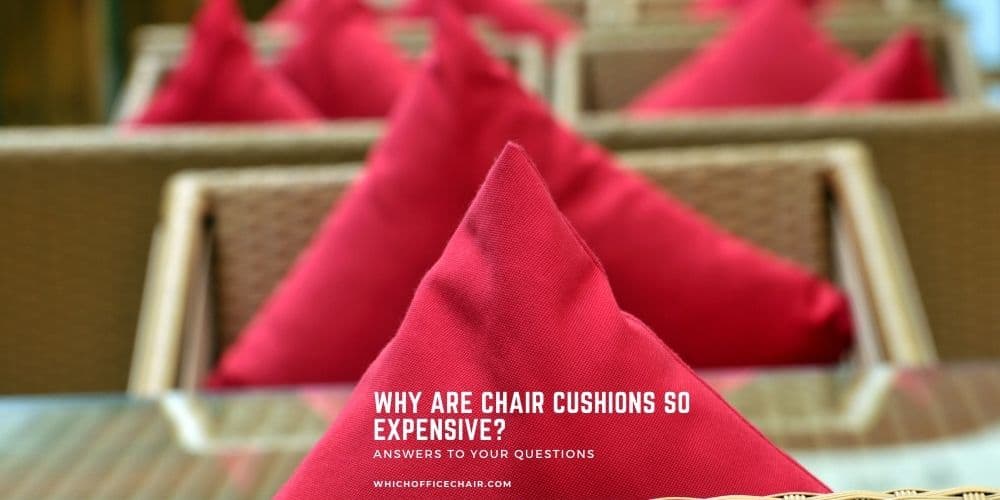How thick should a chair mat be?
A frequently asked question about chair mats is, “how thick should a chair mat be?” Generally, a chair mat should be anywhere from .4″ to one inch in thickness. If you’re not sure what thickness to choose, go with the lesser of the two measurements – a too thick chair mat can be more inconvenient than it’s worth.
Another opinion is that the thickness of the chair mat depends on what type of environment it will be used in. If you are using one for noise reduction purposes, then you might want to consider getting one that is 2-inches thick or more (if possible).
While this can be a little bit more expensive, the benefits are certainly worth it: not only will you be able to reduce noise, but you will also have something much more comfortable to stand or walk on.
As far as carpeted areas go – 1-inch is usually enough to provide good anti-fatigue benefit; however, if space isn’t an issue or price is relatively low…then why not get something thicker? This just makes sense, especially since most people do spend quite a bit of time sitting around their desks at work!
How big are chair mats?
The standard size for an office chair mat is 36″x48″x1″ or about three feet by four feet. This is large enough so that you have plenty of room to use your mouse and keyboard comfortably, but small enough so that you can easily move it out of the way when not in use. The extra foot at each end might seem like a waste of space, but it often ends up being quite useful in accommodating other workspace items like a keyboard tray or printer.
 Office chair mats are available in a variety of sizes and thicknesses.” class=”wp-image-232″/>
Office chair mats are available in a variety of sizes and thicknesses.” class=”wp-image-232″/>How long do chair mats last?
The main determinants of how long a chair mat lasts are the quality of its construction and use. High-quality mats with heavy-duty PVC vinyl will tend to have a longer life span than their cheaper counterparts.
Use also plays an important role in determining how long a mat lasts: if you keep your equipment on top of the surface, the mat won’t be subject to as many spills and stains as one that is constantly rolled out for every meeting; likewise, hard use puts more wear on things like chair casters, which can quickly put holes in even the toughest rubber flooring.
So it’s best to stick with light rolling office chairs when using mats with hard floors. How long should a chair mat last? That depends on the quality of the floor covering and the use that it sees.
What material are chair mats made of?
The most common choice for office chairs is commonly referred to as “Vinyl.” There are many different types of vinyl, but the highest-quality type used in this application is called “PVC Vinyl” or sometimes “Neoprene”.
Other materials such as PET (polyethylene terephthalate) are occasionally found in lower-end products, though they’re usually only seen at the bottom end of a price spectrum and not something you see advertised with higher prices or quality brands.
PVC Vinyl has excellent slip resistance, meaning that it tends to stay where you put it, even when you’re turning at high speeds or trying to push your chair through the mat.
What color should a chair mat be?
The answer to this question depends on what kind of office environment you’re working in.
If your company is like most and has an open floor plan with plenty of room for lighting, then a dark-colored chair mat might help reduce the light reflection from the surface and make your eyes more comfortable.
On the other hand, if you have several identical cubicles with poor lighting or work in a dimly lit retail store all day long, white mats are usually recommended as they won’t reflect as much light back into your eyes from overhead lights.
A third option is gray, which may sound like an odd choice, but it’s becoming increasingly popular amongst a growing number of businesses that are trying to reduce the amount of work surface area covered by chair mats.
Black is an option if you’re using dark-colored flooring, but the best thing about gray is that it brings two big advantages: First, your floor will show less dirt than traditional black or white covers, and second, it looks professional and is easy to clean as well.
What kind of caster do I need? What does a heavy-duty floor mat require?
Casters come in many different shapes and sizes – some more commonly used for kitchen chairs than others. Whether or not you have hard floors determines what type and size of casters you need for your office mat purchase.
Ideally, you should purchase rubber flooring for your chair mat that is at least 3/4-inch thick, if not more.
If the caster holes are spaced too far apart, thin wheels can easily fall through the gaps and make your equipment unusable until you get them unstuck. This also makes moving a full mat difficult because it’s so top-heavy and awkward to roll unless you have larger casters on the front end of your office chair with something like 1 ¼ inch or 1½ inch diameter wheels.
What about non-slip backing? What is it used for?
If you live in an area where there’s no carpet but plenty of hardwood floors or tile, then investing in a quality non-slip backing can save you the expense of frequent replacement.
The most common backing comes in the form of a clear, thick sheet that’s applied to one side of the rubber mat, giving it additional resistance to sliding around on your flooring.
Why is this necessary? Because even when using heavy-duty office chairs with high-quality casters installed on them, there’s still a chance they could get stuck and cause damage to your floors if left without something that grips better than simply rolling over the carpet.
Although slippery surfaces generally do not pose too much of a problem for rubber mats – such as mats with PVC or Neoprene backing – some people prefer a product like Clear Grip ®, which has been used by runners for years due to its excellent traction qualities on most flooring.
The material easily sticks to the top of a 12 x 18-inch non-slip rubber floor mat and creates a surface that grips well when used on tile or hardwood floors, helping your chair stay in place even during periods of acceleration and deceleration.
Making the Purchase – A Guide
Once you’ve decided what types of flooring you want to be covered by your chair mat, it’s time to decide whether you prefer an open pattern design like a 1×1 cable weave or one with smaller squares like our Diamond Pattern.
Next, take a look at the material options available – there are different materials available. For example, Neoprene (the blacktop grain leather option), PVC Vinyl (the grey “pleather” option), and Foam with PVC Vinyl backing.
You’ll also want to consider the thickness of your mat, which depends on what type of floors you have in your office. A thicker product will obviously support more weight and last longer, but if you work regularly with equipment that tips or moves excessively while rolling around on your desk floor mats then a thinner model is usually best – not only for the longevity of the mat itself but also so it’s easier to store away at night.
What if I already have flooring but need protection for it?
Unfortunately, there’s no way to know just how long the floor covering will last before needing to be replaced prior to installation.
Various factors influence whether you’ll require new flooring after installing an office chair mat – mainly the weight of the chair being used and the amount of use it sees every week.
As such, we recommend looking into this question in greater detail before you start shopping around for an attractive rubber floor mat that matches the decor in your office space.
After using your mat for a while, take some time to evaluate it – if you’ve noticed damage to your flooring that’s difficult to repair, then consider purchasing a new office chair mat.
It might not seem like much at first but the more time goes by, the greater chance you’ll have of accidentally ruining the floors in your workspace with an oversized or poorly designed mat.
While there are certainly instances where minor damage can be repaired on-site without having to replace entire sections of floor covering (welding small cracks together is possible in some cases), oftentimes this won’t even work – and all you’re left with is a headache caused by trying to fix something that just isn’t worth saving. That’s why we recommend taking preventative measures now before they become major issues later.
That being said, there are several instances where you will not need to worry about buying new flooring at any point in the near future – these include:
1. If you have just recently installed new tile or wood floors and purchased a matching office chair mat for each space you’d like covered. This is especially true if your business has high traffic areas that see consistent use on a daily basis – which means your mats may wear out before the floors do, making replacement unnecessary for many years afterward.
2. If you’ve laid down brand-new carpeting within your offices and are planning on installing an area rug underneath every office chair in the place (the two can be combined easily without fear of them warring with one another). Again, this is ideal for businesses that have high traffic areas – as the carpet will wear out before your office chair mats do.
3. Finally, if you’ve recently invested in new laminate/wood flooring and are planning on using slip-resistant models with a PVC Vinyl backing to protect it from moisture (i.e., spills or other common workplace accidents). Again, this is best suited for businesses whose employees frequently work around liquids or large amounts of debris – which increases the chances of damaging expensive floor covering when compared with many overly clean environments.
What do I need to do if my office chair mat stretches or rolls up?
This is actually a common problem – especially among office workers that spend the day typing away at a keyboard. After an extended period of time, the rubber will lose its ability to maintain its original shape without continuous use – which means that even with adhesive backing, your mat may eventually start curling or expanding in one section.
Don’t worry though; it’s not going anywhere! What you can do is find the part of your mat that’s stretching out (i.e., where it separates from the floor underneath), and use something heavy to hold it in place while you re-stick the two together. Just place a heavy object on top of the mat (such as a box or even another office chair), and leave it in that position for a few hours to allow time for the adhesive to dry.
Another option is to purchase a rubber backing/bonding agent – using this additive will make your mat much harder to separate from its original location, which means you’ll have an easier time moving around desks without having to worry about breaking things during transit!
Is it possible for me to clean my office chair mat?
Yes! You would be surprised at how many people don’t realize just how easy cleaning mats can be, so we’re here today to give you some directions if you ever find yourself with a dirty mat that needs attention.
First, you want to make sure that the surface isn’t wet or damp – otherwise, you risk sticking and leaving adhesive behind.
Use warm water and dish soap to wash down your mat’s top and sides; remove as much debris from the top as possible (especially sand) before proceeding with the rest of this process.
When finished washing it down, dry the mats entirely using a towel or rag – but make sure not to do this while they’re still wet! Place them in an area where they can dry naturally for several hours before attempting to put anything on them again.
We hope this article has helped you find answers to your queries about office chair mats. If you need more information, don’t hesitate to contact us.
What are anti-fatigue mats?
Anti-fatigue mats are designed to ease the stress on your body by increasing surface area, which in turn makes you less tired as a result of standing – or even after you’ve been sitting at a desk for an extended period of time!
The most common material used in these mats is sand, with each square centimeter containing approximately five pounds of that substance – thus keeping individuals from getting fatigued as easily due to the increased weight bearing down upon them.

Is there anything I should be wary of when using an office chair mat?
Not necessarily; just use common sense at all times, and make sure to maintain it.
For instance, if you spill something on your mat (like a cup of coffee or soda), take a break from using the area until you can clean up the mess properly.
Additionally, don’t leave heavy objects laying where people will walk – this could result in permanent damage to the floor over time. Note: When we say ‘heavy objects’, we mean items that weigh more than 10 pounds total – like printers and other types of equipment.
Are there different types of material that can be used with these mats?
There are four materials that can be used for chair matting: EVA Foam, PVC Coated NBR Rubber, HDPE, and PVC.
For the most part, EVA Foam is probably the best option for those who want something that will provide as much comfort as possible while also reducing noise or providing impact absorption.
On the other hand, if you don’t care about noise reduction or impact absorption (or are doing this for safety reasons), then you might be better off with HDPE (solid): it’s much more flexible than EVA Foam but doesn’t offer as much in terms of comfort or safety benefits.
What type of mat should I get? What kinds of mats are there?
There are four kinds on the market:
• Vinyl Mats – These mats feature a nitrile foam core covered by vinyl fabric; they’re usually pretty affordable and very light in weight (usually less than 3 lbs.). Keep this in mind if you’re looking for something that will reduce noise.
• Fiber Mats – These are similar to vinyl mats, but they feature an injected polypropylene core – which can help absorb more impact than a nitrile foam mat; however, they also tend to be heavier!
• Rubber Matting – These are usually some of the heaviest and thickest options available on the market; as such, their main purpose is to provide comfort from standing – especially when used beneath your office chair. If you want something that will absorb shock or prevent vibrations…then there’s really no point in wasting money on this kind of mat!
• Foam Padded Mats – Finally, there are even some options that combine foam and rubber for maximum comfort; this may be the best option for those who deal with heavy objects on a regular basis or need something that provides great shock absorption. For example: if you work in a warehouse, you might want to consider getting a mat that features foam padding so you can prevent injuries from falling objects! Where should I put my office chair mat?
How do I choose where to place a mat?
This is going to depend on what kind of mat you buy and how much space you have available. Many people like placing their mats beneath their desk, but there are other options as well – such as placing them in front of your workstation so they take up less floor space.
What do these mats smell like when they’re new?
Will it take a long time for a “new” smell to go away? It depends! If you buy one that has a strong chemical odor – then yes, it will probably take several months before you notice much of a change. (There are some people who even have problems with the smell lingering on mats that don’t have an odor!)
What can I do if my office chair mat is showing wear?
If you’re worried about your mat showing signs of excessive wear, then avoid products that come with a thick coating of rubber. Instead, go for polyurethane foam (remember: EVA Foam) if you want something that will last!
Final Thoughts
We hope this article has answered most of your questions about floor and chair mats. Office chair mats are certainly worth a small investment. In case you have further questions or any comments, please feel free to talk to us!






